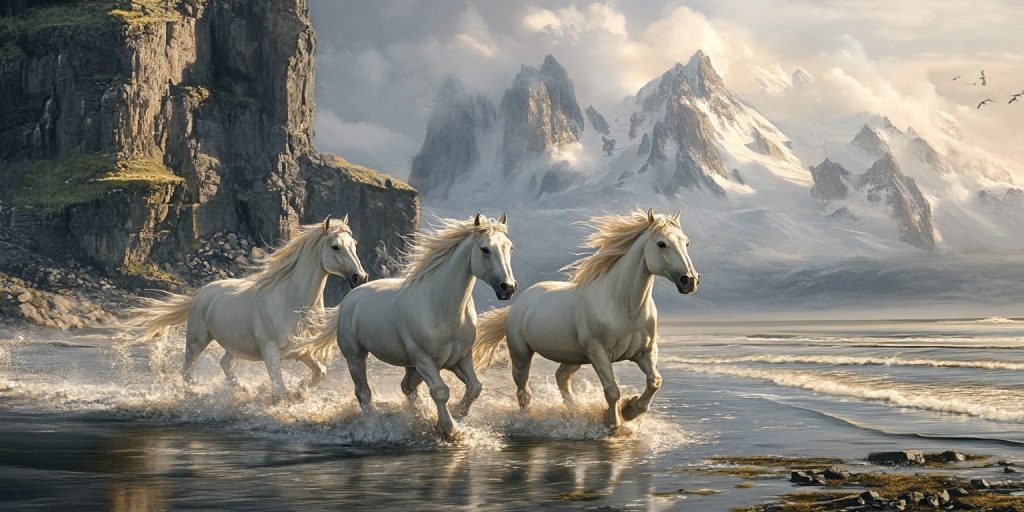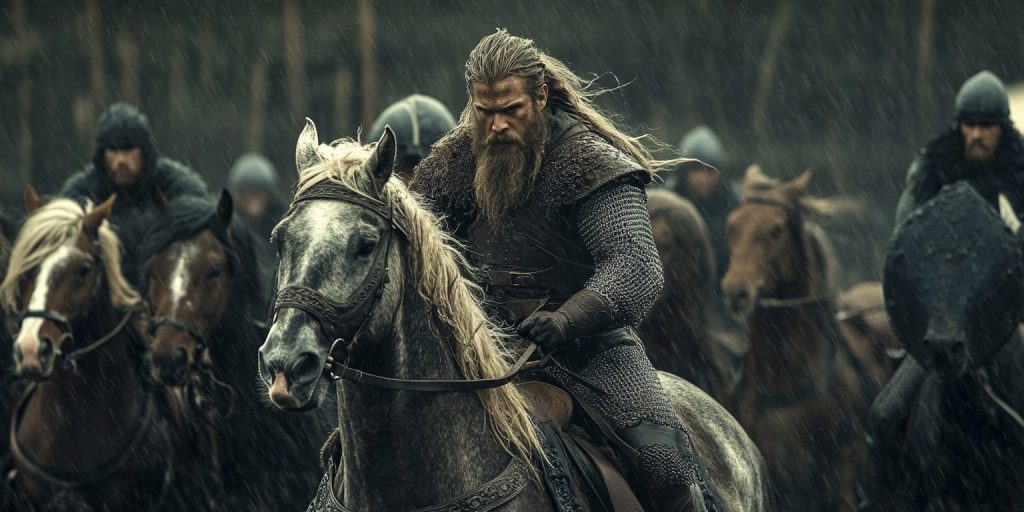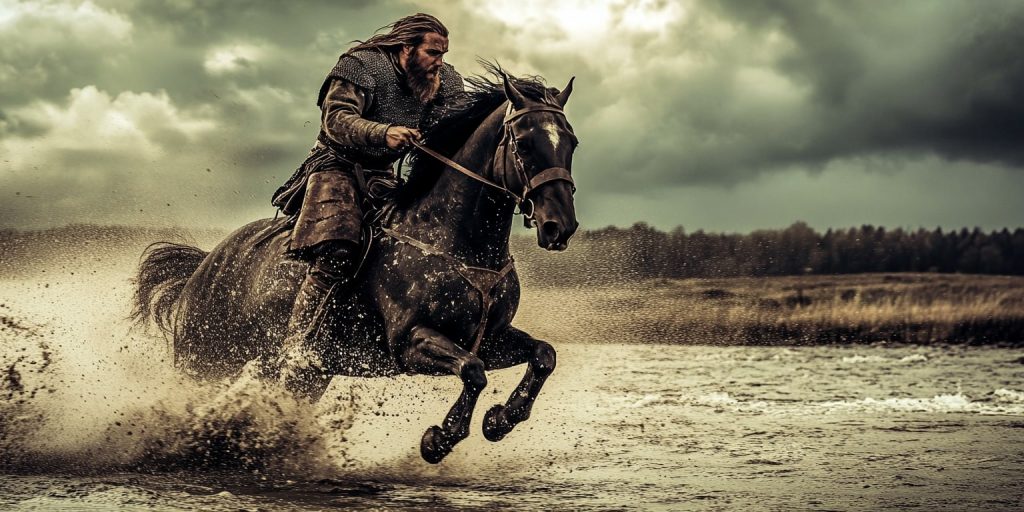Daily Life in the Viking Age, Viking Raids and Warfare, Vikings
Did Vikings Ride Horses?
The Viking Age lasted from about 793 to 1066 AD. It was a time of great exploration, raids, and trade for the Vikings. They used horses in many ways, making us wonder whether Vikings rode war horses.
Archaeological finds, old texts, and Norse sagas tell us a lot. They show that horses were key in Viking life. They were important for daily tasks and were a big part of their culture.
We will examine how Vikings used horses, particularly in Iceland, and their raids across distant lands. This will show their value in Viking society, where different breeds of horses were essential. It will also highlight the different ways Viking riding horses are used.
Introduction to Viking Horsemanship
Horses were key in Viking society, playing many roles in their lives. They were more than just a way to get around. Horses showed wealth, strength, and status to the Vikings. Archaeological finds show how important horses were in Viking communities.
The Importance of Horses in Viking Society
Horses helped with farming, making plowing and working the land easier. They were also vital for trade and exploring new places. The Vikings’ skilled use of gaited horses allowed them to travel far and meet other cultures.
In Norse myths, horses were special, like Odin’s Sleipnir. This shows the deep bond between humans and horses, which was a big part of Viking culture.
Overview of Viking Settlements and Equine Practices
Viking settlements were near good pastures for horses. This helped the Vikings breed horses for different needs. They bred horses for work, speed, or endurance.
This careful breeding made horses more useful in daily life and travel, especially for the Vikings, who relied on ambling horses. Horses were a big part of Viking society, showing their importance in practical and cultural ways, much like the Icelandic horse breed.
Did Vikings Ride Horses?
Looking into did Vikings have horses gives us a peek into their culture and daily lives. Archaeology shows us how important horses were to them, as evidenced by artifacts and stories from the time.
Evidence of Horse Riding in Viking Culture
Many finds show Vikings loved riding horses. Excavations at burial sites often find horse gear like bridles and saddles. This shows horses were more than just a ride; they were friends in Viking homes.
Stories from Norse mythology also tell us about horses and their significance. They were often associated with Odin and Loki and seen as signs of wealth and power.
Types of Horses Used by the Vikings
So, what horses did Vikings ride? Vikings had different horses for different needs. Their horses were good at going over rough land and long trips. The Icelandic horse was especially good at this.
These horses helped Vikings travel and work on farms, demonstrating their versatility as a horse breed. They were very useful and loved by the Vikings.
Characteristics of Viking-Era Horses
The Viking era was known for its amazing horses, especially the Icelandic horses. These horses were known for their endurance and special traits, which originated from careful breeding practices. Knowing these traits helps us understand how they were used back then.
Understanding Icelandic Horses and Their Traits
Icelandic horses are special because of their unique looks, ambling gaits, and behavior. They have a strong build, sturdy legs, and thick manes, which help them survive in tough weather.

They are famous for:
- Being able to go long distances.
- Being gentle, ambling horses are good for all riders, reflecting the Vikings’ understanding of horse breeds.
- Having unique gaits like ‘tölt’ for a smooth ride.
- ‘Flying pace,’ a fast gait for quick travel.
These qualities made Icelandic horses very valuable in the Viking era. They were key for travel and battles, often serving as war horses.
The Role of Gaits in Viking Riding Techniques
The gaits of Viking riding horses were important for their riding skills. Different gaits, including the gallop and tölt, helped riders move well on different terrains. Key gaits include:
- Trot: Like the tölt, a diagonal gait ensured steady travel across rugged terrain.
- Canter: A three-beat gait for faster travel.
Knowing and using these gaits improved Viking riding. It helped them move well in battles and on long trips. Being good at using different gaits gave the Vikings an edge in many situations.
Vikings and Their Use of Horses in Warfare
The Vikings used horses smartly in their wars, which changed how they fought. Knowing how horses helped them shows how good their battle plans were.
Strategic Importance of Horses in Viking Battles
Horses helped Vikings move fast and fight well, playing a crucial role in horses in battle. They were key in many ways:
- Mobility lets Viking forces quickly join or leave fights.
- Mounted warriors could scout and send messages fast.
- Horses helped Vikings surprise enemies with quick attacks.
Switching from horseback to fighting on foot was a big plus. This made Viking warriors stronger than others. History shows horses were more than just a way to get around.

Differentiating Light Cavalry and Heavy Cavalry Roles
Viking cavalry was split into light and heavy types. Each had its job:
- Light Cavalry: Fast riders for quick attacks and chasing. They were good at fast fights and quick escapes.
- Heavy Cavalry: Heavily armored knights for big battles. They scared enemies and were strong at the front.
Both types of cavalry made the Vikings flexible in battle, showing how important horses were in their fights. Working together, these cavalry types helped the Vikings win.
Conclusion
Did Vikings use horses? Absolutely, Vikings used horses in many ways, showing their importance. Horses helped with farming and battles, making Viking life and stories rich and meaningful.
Viking riders knew how to use horses well. They used special horses, like the Icelandic horse, which helped Vikings travel and settle new lands.
The Vikings’ love for horses still affects horse riding today. Their skills and knowledge are still used. Horses were more than just animals to Vikings. They were friends and helpers.

